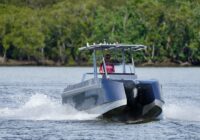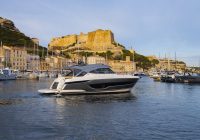It was when the planes were grounded and while Alex Kepper was on a friend’s Riviera 57 Flybridge that he bumped his shin one night and thought ‘why not put a light in the handrail?’ and it started from there – Aqua Rail was born.
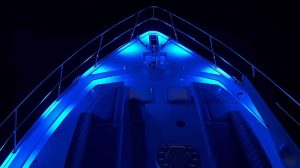
The way the lights face down protects your night vision.
The pandemic had a hand in changing a lot of things in the world, introducing remote working, and temporarily retiring people from jobs, which ironically freed up a lot of sharp minds to refocus their attention on inventing better ways to live, work and play.
One of those people was Riviera 64 Sports Motor Yacht owner and now Aqua Rail director Alex Kepper, who has spent most of his life around boats, owned a number of Rivieras, and while a commercial pilot he also refers to himself as a jack of all trades.
It was when the planes were grounded and while he was on a friend’s Riviera 57 Flybridge that he bumped his shin one night and thought ‘why not put a light in the handrail?’ and it started from there – the Aqua Rail idea was born. His former work in manufacturing and electronics manufacturing came to the fore, along with a couple of good industrial designer friends, and Aqua Rail was created.
Alex says the existing courtesy lights are usually mounted in the lower superstructure whereas the handrails offer the elevation for a wider distribution of light on the surfaces being illuminated – including walkways. “And because they are going into a handrail and not into the superstructure, they are quite easy to fit as an after-market product, and quite affordable.”
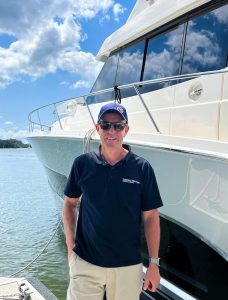
Riviera 64 Sports Motor Yacht owner and Aqua Rail director Alex Kepper.
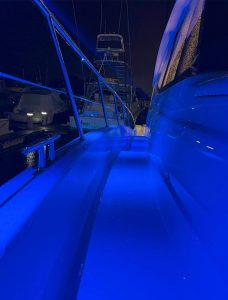
The lights are installed to ensure the walkways are well illuminated.
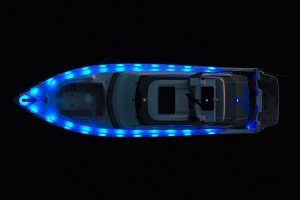
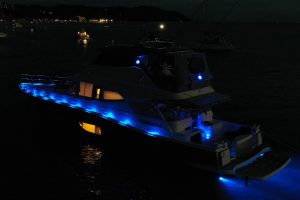
Alex says the lights are made for different diameter rails, 32mm for Rivieras, and they vary in size with fittings specifically made for each diameter rail.
“They are designed to seal well in the rail, and I suppose if I were to sit and analyse what most of the development time was spent on, it was the installation process.
“We spent a lot of time developing a specialised jig fixture that allows you to be very precise with the installation and not damage the rail in any way.
“Also, the way we trace the cable through the rail, without giving away all my trade secrets, is that we do it magnetically. We trace a magnet through and can very easily pull the cabling through once we have cut all the holes.
“Put simply, where the rail goes onto the deck we trace the cables through at that point, just one point of entry into the deck per side – in Rivieras the rails generally join to the deck through an open bottomed stanchion base plate close to the engine room.
“The setup method we use for Riviera is that we run an LED driver on each side, so a single driver powers a run of 12 or so LEDs in the handrail – that’s about as many as you are going to use.
“These lights are very low voltage, about three volts for, say, a Riveria 64, with the total current drawn less than two amps. They are designed so you can leave them on, and they are not going to run down your batteries overnight.”
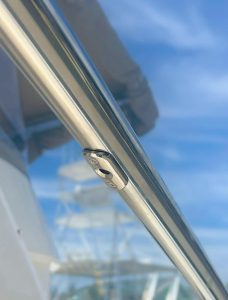
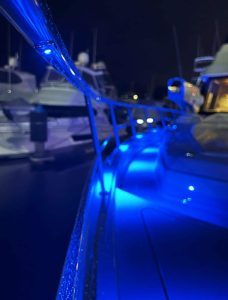
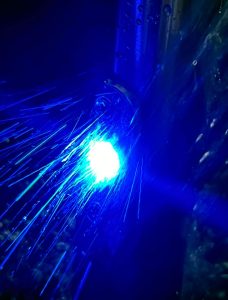
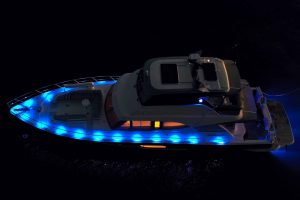
Alex said the most important issue was to angle the light on the installation to ensure the area being illuminated is properly lit. “Most of the Rivieras are at 15 degrees from centre to ensure the walkways are well illuminated, and the other reason is that at night it is very easy to anchor and use all the ancillary equipment on the boat’s forward deck without having bright direct lighting which ruins your night vision.
“The way the light faces, down and with not too high a wattage, means at night you can still see the surface, but it is not overly bright, which once again protects your night vision. We do only blue and white. Green or red could cause a few issues in terms of navigation, and I actually quite like the white colour.
“The beauty of the product we have designed is that it can be serviced in the field, making it easy to change the colour or replace a light globe that may have failed. I want people to be able to fix things themselves and replace them at a reasonable cost. The fitting is the most expensive component. We machine them out of solid 316 stainless so that is the costly part, not the light itself.” Alex said the Aqua Rail lights were also being placed in awning frames and biminis as they are currently an after-market product.
Chris Brown from Riviera Aftermarket said: “The cost of installation varied by model size and owner requirements; however, an average cost would be around AUD $10,000 for most installations.
“Their main purpose is to illuminate the side walkways and this assists with models that have small side steps which are well lit because of the installation. So, they are an additional safety aspect, and they look fantastic too.
“We’ve had this option for only a few months, and they are now quite popular.
“They really complement the existing courtesy lights, and I think people are finding them a good addition for their functionality on the side decks and foredeck at night, creating a great ambience. They are also relatively easy to install.”
The Aqua Rail system can be retrofitted to your Riviera yacht through Riviera Australia’s Aftermarket department based at the manufacturing facility at Coomera, and perfectly complement the safety of the courtesy lights that are fitted to your Riviera.





